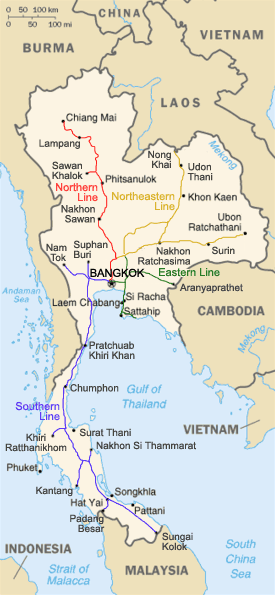Our website is made possible by displaying online advertisements to our visitors.
Please consider supporting us by disabling your ad blocker.
Rail transport in Thailand
| Rail transport in Thailand | |||||
|---|---|---|---|---|---|
Clockwise from top: KiHa 183 at Thung Song Hong station, MRT Blue Line, SRT Red Lines, Alstom AD24C at Kanchanaburi | |||||
| Operation | |||||
| National railway | State Railway of Thailand | ||||
| Major operators | BTSC Silom Sukhumvit Gold BEM Blue Purple Orange AERA1 ARL SRTET Light Red Dark Red Eastern Bangkok Monorail Company Limited and Northern Bangkok Monorail Company Limited MRT MRT | ||||
| Statistics | |||||
| Ridership | 488.74 million a year (2023) [1] | ||||
| System length | |||||
| Total | 4,845.1 km (3,010.6 mi) (2023)[2] | ||||
| Electrified | 276.15 km (171.59 mi) (2025)[3] | ||||
| Track gauge | |||||
| Main | 1,000 mm (3 ft 3+3⁄8 in) 1,435 mm (4 ft 8+1⁄2 in) | ||||
| Features | |||||
| Longest tunnel | Dong Phaya Yen Tunnel 5.850 km (3.635 mi)[4] | ||||
| |||||
Rail transport plays a crucial role in connecting various regions of Thailand, transporting both goods and passengers through a range of transportation options that include inter-city and commuter rail, mass rapid transit, monorails, and airport rail links. The State Railway of Thailand (SRT) operates a network of intercity railways spanning 4,845.1 kilometers,[2] covering 47 provinces across the country.[5] SRT is committed to developing railway lands through its subsidiary, SRT Asset (SRTA), which focuses on transit-oriented development (TOD) initiatives. The Krung Thep Aphiwat Central Terminal in Bangkok serves as the primary transportation hub for rail transport in Thailand, connecting various types of rail transportation throughout the country. It covers an area of 274,192 square meters, making it the largest railway station in Southeast Asia, and is situated in a new central business district (CBD) that is currently being developed.
To further expand and improve its railway network, particularly through the construction of double-track railways, Thailand has invested in several expansion projects. The first phase of this expansion project covers seven routes, two of which have been completed, while the remaining five are under construction. The second phase of the expansion project is expected to begin construction in 2023. There are also plans for 12 new railway routes with a total distance of 2,419 kilometers, which will increase the number of provinces with railways passing through them to 61.[6]
The mass rapid transit system in Bangkok and its surrounding areas has been operating since 1999. It comprises elevated, ground-level, underground, and under-river electric trains, spanning 211.94 kilometers with 11 routes and 141 stations. The network is expanding with five new lines and six extensions currently under construction, bidding, or preparation.[3]
Thailand is also investing in high-speed rail to enhance its rail transport system. Currently, the Bangkok–Nong Khai route and the Bangkok–U-tapao route are under construction, covering 608 kilometers and 220 kilometers, respectively. There are also plans to construct two more high-speed rail lines, the Bangkok-Chiangmai route and the Bangkok-Padang Besar route, in the near future.
- ^ Department of Rail Transport - Statistics, retrieved 22 January 2024
- ^ a b SRT 2023, p. 50.
- ^ a b อัพเดตแผนที่รถไฟฟ้า กทม.-ปริมณฑล ทุกสาย รวม 33 โครงการ, 28 January 2025
- ^ รวมที่สุด ของโครงการรถไฟทางคู่ของไทย (in Thai), 23 February 2023
- ^ SRT 2023, p. 102.
- ^ OTP & April 2021, p. 17.
Previous Page Next Page







